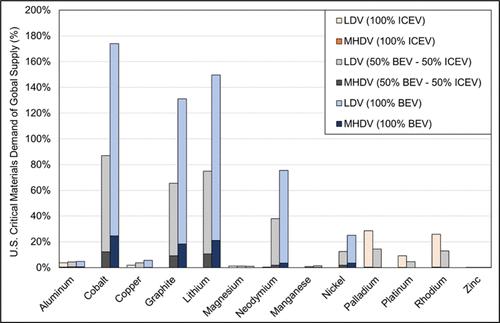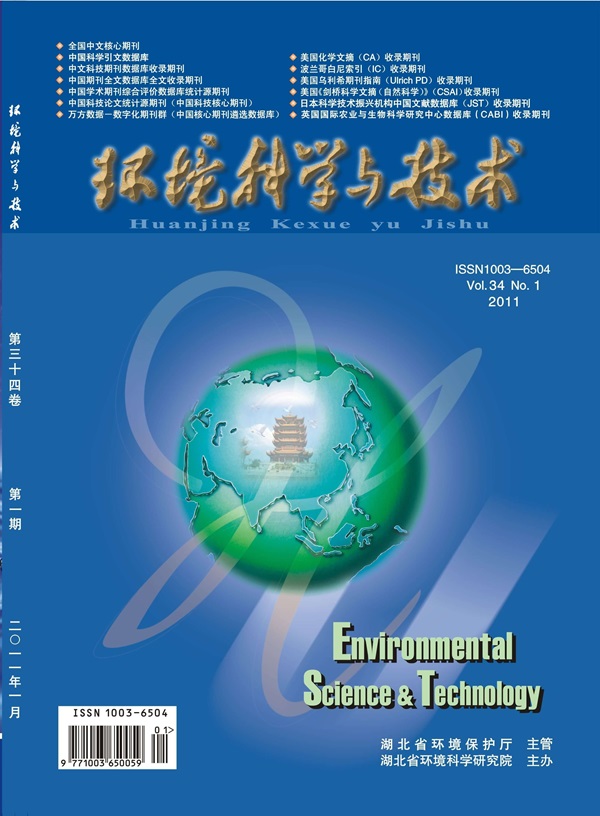美国道路车辆电气化和轻量化对关键材料需求的影响
IF 10.8
1区 环境科学与生态学
Q1 ENGINEERING, ENVIRONMENTAL
引用次数: 0
摘要
交通运输部门的电气化对于减少温室气体排放和减少对化石燃料的依赖至关重要。纯电动汽车(bev)的电池和电子元件依赖于关键材料(CMs),但由于CMs的可用性有限,其广泛采用可能面临限制。本研究评估了汽车电气化和轻量化(材料替代)对美国轻型车辆(LDVs)和中型和重型车辆(MHDVs)的CM需求的影响。考虑了100%内燃机汽车(ICEVs)、100%纯电动汽车(bev)和50%/50%混合动力车的市场销售情景。研究结果显示,低密度车主导着总CM需求,尽管高密度车每辆车需要更多的CM。钴、石墨、锂、钕和镍对100%纯电动汽车的采用至关重要,而钯和铑对icev至关重要。LDV轻量化增加了每辆车的CM总量,因为用铝代替了钢,但减少了车辆的质量、运行能耗以及对高度关注的电池相关CM的依赖。从镍锰钴(NMC622)电池化学过渡到磷酸铁锂(LFP)电池化学减少了CM的使用,但增加了对铜和磷等战略材料的需求。该研究独特地评估了美国汽车制造商对传统动力系统和电动动力系统中LDVs和MHDVs的需求,并调查了轻量化和电池化学影响。本文章由计算机程序翻译,如有差异,请以英文原文为准。

Impact of On-Road U.S. Vehicle Electrification and Lightweighting on Critical Materials Demand
The electrification of the transport sector is crucial for reducing greenhouse gas emissions and the reliance on fossil fuels. Battery electric vehicles (BEVs) depend on critical materials (CMs) for their batteries and electronic components, yet their widespread adoption may face constraints due to the limited availability of CMs. This study assesses the implications of vehicle electrification and lightweighting (material substitution) on the U.S. CM demand for light-duty vehicles (LDVs) and medium- and heavy-duty vehicles (MHDVs). Market sales scenarios of 100% internal combustion engine vehicles (ICEVs), 100% BEVs, and a 50%/50% mix are considered. The findings reveal that LDVs dominate the total CM demand despite MHDVs requiring more CMs per vehicle. Cobalt, graphite, lithium, neodymium, and nickel are critical for the 100% BEV adoption scenario, whereas palladium and rhodium are critical for ICEVs. LDV lightweighting increases total CM quantity per vehicle due to steel replacement with aluminum but reduces the vehicle’s mass, operational energy consumption, and reliance on high-concern battery-related CMs. Transitioning from nickel manganese cobalt (NMC622) to lithium iron phosphate (LFP) battery chemistry reduces CM use but increases demand for strategic materials such as copper and phosphorus. This study uniquely evaluates U.S. CM demand for LDVs and MHDVs across conventional and electric powertrains and investigates light-weighting and battery chemistry impacts.
求助全文
通过发布文献求助,成功后即可免费获取论文全文。
去求助
来源期刊

环境科学与技术
环境科学-工程:环境
CiteScore
17.50
自引率
9.60%
发文量
12359
审稿时长
2.8 months
期刊介绍:
Environmental Science & Technology (ES&T) is a co-sponsored academic and technical magazine by the Hubei Provincial Environmental Protection Bureau and the Hubei Provincial Academy of Environmental Sciences.
Environmental Science & Technology (ES&T) holds the status of Chinese core journals, scientific papers source journals of China, Chinese Science Citation Database source journals, and Chinese Academic Journal Comprehensive Evaluation Database source journals. This publication focuses on the academic field of environmental protection, featuring articles related to environmental protection and technical advancements.
 求助内容:
求助内容: 应助结果提醒方式:
应助结果提醒方式:


